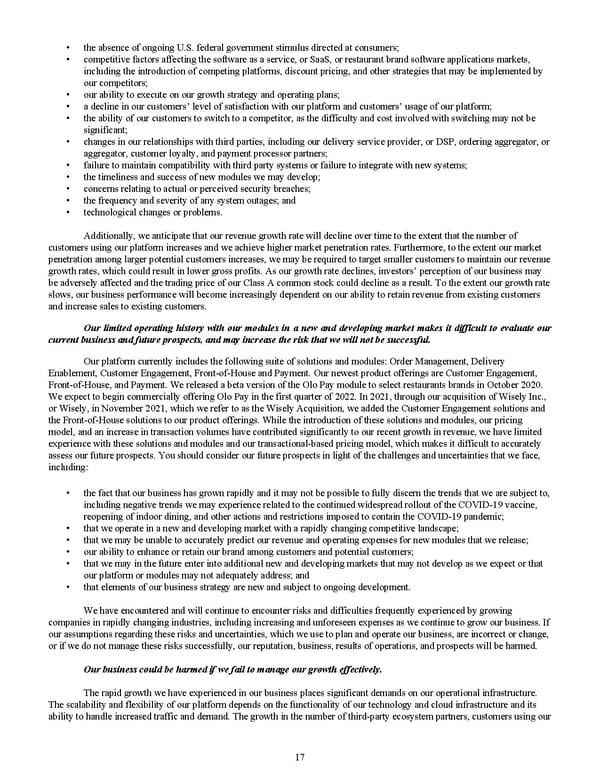• the absence of ongoing U.S. federal government stimulus directed at consumers; • competitive factors affecting the software as a service, or SaaS, or restaurant brand software applications markets, including the introduction of competing platforms, discount pricing, and other strategies that may be implemented by our competitors; • our ability to execute on our growth strategy and operating plans; • a decline in our customers’ level of satisfaction with our platform and customers’ usage of our platform; • the ability of our customers to switch to a competitor, as the difficulty and cost involved with switching may not be significant; • changes in our relationships with third parties, including our delivery service provider, or DSP, ordering aggregator, or aggregator, customer loyalty, and payment processor partners; • failure to maintain compatibility with third party systems or failure to integrate with new systems; • the timeliness and success of new modules we may develop; • concerns relating to actual or perceived security breaches; • the frequency and severity of any system outages; and • technological changes or problems. Additionally , we anticipate that our revenue growth rate will decline over time to the extent that the number of customers using our platform increases and we achieve higher market penetration rates. Furthermore, to the extent our market penetration among larger potential customers increases, we may be required to target smaller customers to maintain our revenue growth rates, which could result in lower gross profits. As our growth rate declines, investors’ perception of our business may be adversely affected and the trading price of our Class A common stock could decline as a result. To the extent our growth rate slows, our business performance will become increasingly dependent on our ability to retain revenue from existing customers and increase sales to existing customers. Our limited operating history with our modules in a new and developing market makes it difficult to evaluate our current business and future prospects, and may increase the risk that we will not be successful. Our platform currently includes the following suite of solutions and modules: Order Management, Delivery Enablement, Customer Engagement, Front-of-House and Payment. Our newest product offerings are Customer Engagement, Front-of-House, and Payment. We released a beta version of the Olo Pay module to select restaurants brands in October 2020. We expect to begin commercially offering Olo Pay in the first quarter of 2022. In 2021, through our acquisition of Wisely Inc., or Wisely, in November 2021, which we refer to as the Wisely Acquisition, we added the Customer Engagement solutions and the Front-of-House solutions to our product offerings. While the introduction of these solutions and modules, our pricing model, and an increase in transaction volumes have contributed significantly to our recent growth in revenue, we have limited experience with these solutions and modules and our transactional-based pricing model, which makes it difficult to accurately assess our future prospects. You should consider our future prospects in light of the challenges and uncertainties that we face, including: • the fact that our business has grown rapidly and it may not be possible to fully discern the trends that we are subject to, including negative trends we may experience related to the continued widespread rollout of the COVID-19 vaccine, reopening of indoor dining, and other actions and restrictions imposed to contain the COVID-19 pandemic; • that we operate in a new and developing market with a rapidly changing competitive landscape; • that we may be unable to accurately predict our revenue and operating expenses for new modules that we release; • our ability to enhance or retain our brand among customers and potential customers; • that we may in the future enter into additional new and developing markets that may not develop as we expect or that our platform or modules may not adequately address; and • that elements of our business strategy are new and subject to ongoing development. We have encountered and will continue to encounter risks and difficulties frequently experienced by growing companies in rapidly changing industries, including increasing and unforeseen expenses as we continue to grow our business. If our assumptions regarding these risks and uncertainties, which we use to plan and operate our business, are incorrect or change, or if we do not manage these risks successfully, our reputation, business, results of operations, and prospects will be harmed. Our business could be harmed if we fail to manage our growth effectively. The rapid growth we have experienced in our business places significant demands on our operational infrastructure. The scalability and flexibility of our platform depends on the functionality of our technology and cloud infrastructure and its ability to handle increased traffic and demand. The growth in the number of third-party ecosystem partners, customers using our 17
 2022 10K Page 23 Page 25
2022 10K Page 23 Page 25